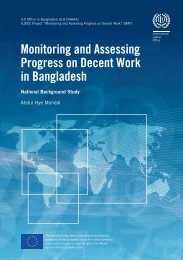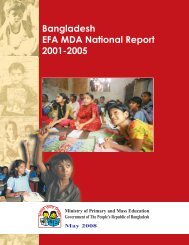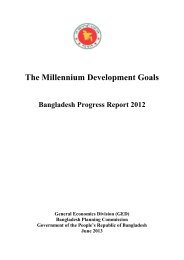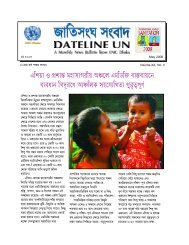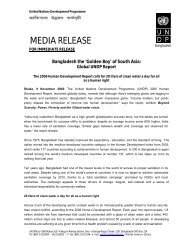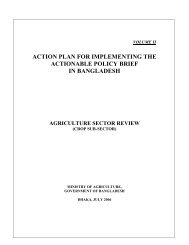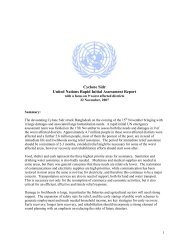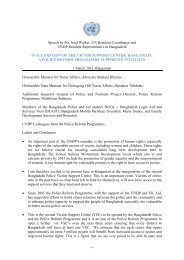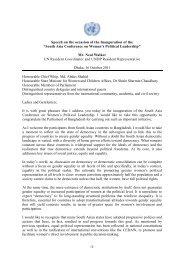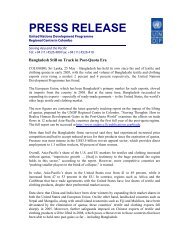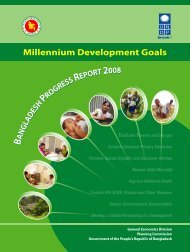Towards an Arsenic Safe Environment in Bangladesh - Unicef
Towards an Arsenic Safe Environment in Bangladesh - Unicef
Towards an Arsenic Safe Environment in Bangladesh - Unicef
- No tags were found...
You also want an ePaper? Increase the reach of your titles
YUMPU automatically turns print PDFs into web optimized ePapers that Google loves.
WHAT HAS BEENDONEAfter the detection of arsenic <strong>in</strong> the groundwater <strong>in</strong> the 1990s, a series of<strong>in</strong>itiatives were undertaken by the government, non-governmental org<strong>an</strong>izations(NGOs) <strong>an</strong>d development partners. This resulted <strong>in</strong> a reasonable assessment of theextent of arsenic problem from tube wells (Figure 1).Almost 5 million of h<strong>an</strong>d pumps <strong>an</strong>d tube wells across the country weredemarcated red or green to <strong>in</strong>dicate arsenic level. The red pa<strong>in</strong>ted wells are <strong>in</strong>exceed<strong>an</strong>ce of the B<strong>an</strong>gladesh dr<strong>in</strong>k<strong>in</strong>g water st<strong>an</strong>dard for arsenic, whereas thegreen pa<strong>in</strong>ted wells are <strong>in</strong> compli<strong>an</strong>ce. The red/green pa<strong>in</strong>t<strong>in</strong>g of the wells hasbeen a powerful way of <strong>in</strong>form<strong>in</strong>g users of the status of the arseniccontam<strong>in</strong>ation. However, this has not always been sufficient to prompt the usersto switch from the red pa<strong>in</strong>ted wells to the green pa<strong>in</strong>ted wells, <strong>an</strong>d the pa<strong>in</strong>tedcolor did not last long.More th<strong>an</strong> 100,000 safe water po<strong>in</strong>ts have been <strong>in</strong>stalled <strong>in</strong> arsenic affected areass<strong>in</strong>ce the discovery of the arsenic problem, with the great majority be<strong>in</strong>g deeptube wells. However, the target<strong>in</strong>g of these water sources to the most affectedareas has been poor <strong>an</strong>d <strong>an</strong> <strong>Arsenic</strong> Policy Support Unit study found that m<strong>an</strong>y ofthose water po<strong>in</strong>ts were not operational with the exception of deep tube wells.Six arsenic removal technologies have been approved by the B<strong>an</strong>gladesh Councilof Scientific <strong>an</strong>d Industrial Research. There are concerns regard<strong>in</strong>g theperform<strong>an</strong>ce, affordability <strong>an</strong>d susta<strong>in</strong>ability of these technologies.The no-longer exist<strong>in</strong>g National <strong>Arsenic</strong> Mitigation Information Centre (NAMIC)held a database of arsenic tube well screen<strong>in</strong>g results (Figure 1). This valuabledataset has now been <strong>in</strong>corporated <strong>in</strong>to <strong>an</strong>other government database to bepreserved, updated <strong>an</strong>d ultimately exp<strong>an</strong>ded to m<strong>an</strong>age groundwater resources<strong>an</strong>d to ensure dr<strong>in</strong>k<strong>in</strong>g water quality st<strong>an</strong>dards to be met <strong>in</strong> B<strong>an</strong>gladesh.Accord<strong>in</strong>g to the archived NAMIC dataset, of the 4.94 million wells screened, 1.44million were found to conta<strong>in</strong> arsenic above 50 microgram per liter <strong>in</strong> 270 upazilasfrom 54 districts. In these upazilas 38,430 suspected arsenicosis patients wereidentified out of the total 66,034,962 residents, although there are somequestions about the validity of the arsenicosis patient screen<strong>in</strong>g data.



